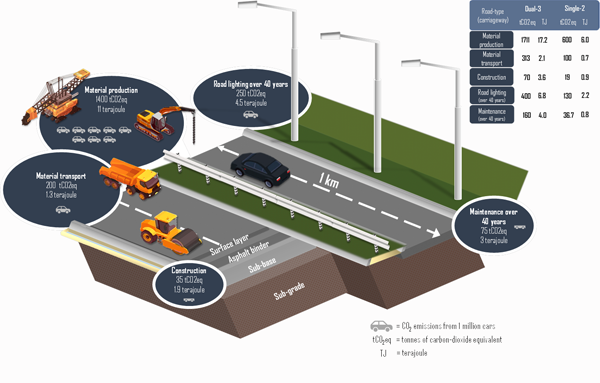Images of climate innovation
Embodied Carbon in Transport: a massive concern marginalised
This image represents the embodied carbon in a dual-2 lane road, as a scale of an average-sized car's tailpipe emissions. For net-zero, road transport must ideally reach 'absolute zero'. The current trends of side-lining its infrastructure emissions will lead to perverse outcomes in 2050. At the University of Leeds, we are working to establish benchmark carbon estimates for the road infrastructure, serving as a useful resource for future road-scheme carbon assessments.

'Embodied carbon' in transport infrastructure (such as a new road) refers to the greenhouse gas emissions produced in its construction, maintenance, and operation. The UK Government's published work on transport decarbonisation acknowledges that embodied carbon exists but makes no commitments to reduce it. This risks project appraisals overlooking these impacts which may lead to perverse outcomes. For example, we are currently maintaining 400,000 km of road and the Government's Road Investment Strategy promises 4,000+ additional lane-kilometres by 2025.
Embodied carbon from road construction includes the emissions from manufacturing the raw materials, transporting them to the site, and the construction process itself. Embodied carbon from maintenance and operation is calculated over a 40-year period and this includes emissions from road lighting, and from routine and periodic maintenance works.
The illustration shows our estimates of whole-life carbon present in 1km of a new two-lane dual carriageway ('Dual 2'), quantified as an average-sized car's tailpipe emissions. Generally, the whole life carbon of roads fall between 800-2700 tCO2eq per km, depending on the scale of construction (Single-2 lane to Dual-3). Collaborating with Transport for the North (TfN), we aim to integrate embodied carbon evaluation into standard road-scheme appraisal by developing future scenarios and employing life cycle assessment principles. This research lays the foundation for a future high-level carbon-based sustainability assessment within TfN's existing scheme-evaluation process.
Our research supports this integration by developing the evidence via an embodied carbon threshold under 'business-as-usual' and 'accelerated net-zero' scenarios, accounting for technological innovations in material sourcing, construction methods, and low-carbon energy integration over the asset's service period. In the long-term, the proposed methods will equip local authorities, large organisations, and others in the governance framework with the necessary benchmark estimates for both future schemes and existing road-network management schemes.
Entrant: Kadambari Lokesh , Institute for Transport Studies
Copyright: Kadambari Lokesh
Funding: EPSRC; grant no: EP/S032002/1
Collaborators: Dr Danielle Densley-Tingley (University of Sheffield and Transport for the North)